-
Posts
816 -
Joined
-
Last visited
Content Type
Forums
Events
Store
Video Gallery
Posts posted by JulioHerrlein
-
-
Now we have
length-legato
Just revisiting the forum...
In the search of length-delta-map examples.
Best !
-
Looks great !
Thank you !
-
Very nice information, Andre ! I didn´t know this technique !
In english sounds like structural network, I suppose.
It´s beautiful when some intuition resonates with music history. Feels like going in the right direction.
Thank you !
Best !
Julio
-
Thanks, Andre ! I will check the Lachenmann piece, for sure.
I was thinking in a possible algorithm for such function:
1) Take an OMN expression
2) Calculate the empty spaces (rest space)
3) Fill the spaces with notes, based on each gap, using a predefined quantization (1/16, 1/8, random, etc) and a filling density level (0-100 %, of the space)
4) Fill the spaces with predefined pitch lists, motifs, rhythmmic sets, etc, that can be trimmed, rotated and start on any note
5) Fill the spaces like mentioned before with some pitch quality control (tonality-map) and pitch melodic direction control (up, down, repeat, vector).
6) Fill the spaces like before with any predefined method
populate-spaces
populate-gap
fill-spaces
fill-gap
This would be really useful, IMHO.
All the best !
Julio
- Stephane Boussuge and AM
-
 2
2
-
Something like this

For a more refined Idea, this population could be oriented by tonality-map for chord-guided notes and some vector (for melodic directions).
Thanks, Stephane
I´ll try your suggestion
-
THINKING OUT LOUD (some hours after)....
Actually, I'd like to have a function or a kind of method that allow me to insert notes and rhythms between some "anchor points", that remains unaltered.
Like inserting ornaments in a choral chordal texture: you have a sequence of chords you don't want to alter, but you need melodic movement between this chords.
This is a procedure I usea lot: starting from block harmony and then fill the gaps between chords in a more polyphonic oriented texture.
-
Dear friends,
I´m looking for a specific kind of repeating function.
In the example below, I have one d4 in the first violin. Then comes an a4, etc.
LOOKING FOR SOMETHING LIKE:
1) to have repetitions of the same note in the blank space (instead of pauses), but all have to be measured inside the exact space that is between the first and second note. Sometimes this spaces of rests are different among each pair of subsequent notes. The function must calculate the spaces among each pair of notes before making the repetitions
2) alternatively, this repetitions could be kind of irregular, leaving some spaces of pauses, like a density control.
Is there something similar to this function already in Opusmodus ?
Thank you !
Best !

For each voice, I use a expression like this:
(setf v1 (make-omn :length (span vuzapit vuzarit1) :pitch (ambitus 'violin vuzapit) :velocity dynhomo)) -
Is there some function in Opusmodus for Vuza Canons ?
It´s very interesting !
All the best !
Julio
 Rhythmic canons (6) – alpof
ALPOF.WORDPRESS.COMThis post is a follow-up on the subject of rhythmic canons and the last post. Today I will talk specifically about Vuza canons, i.e. non-periodic canons. I'll start with an example. Let's take the motive $latex A=\{0,1,8,9,17,28\}$. Can this be a motive for a rhythmic canon, i.e. does it tile $latex \mathbb{Z}_n$ for some integer…
Rhythmic canons (6) – alpof
ALPOF.WORDPRESS.COMThis post is a follow-up on the subject of rhythmic canons and the last post. Today I will talk specifically about Vuza canons, i.e. non-periodic canons. I'll start with an example. Let's take the motive $latex A=\{0,1,8,9,17,28\}$. Can this be a motive for a rhythmic canon, i.e. does it tile $latex \mathbb{Z}_n$ for some integer… -
I use to create a standard OPMO file for the functions I want to study and learn more.
And I put this files into FOLDERS in the left side (I call the folder "Functions"
So, I copy the text of the documentation to the .opmo file and I can do my annotations
and my examples in this.
I think it's important that the updates come with the new revised functions and having the option to not update the function can create some confusion and led you to not have the right documentation.
All the best !
Julio
Just my 2 cents (I'm a user, like you).
-
Thank you, Janusz !
In my folder I did not found this.
Another idea would be to make a :snippet or :clef keyword inside the expression
All the best !
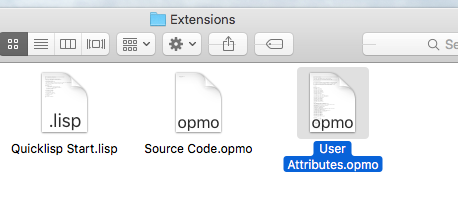
-
Dear Friends,
After using my guitar to make some realtime midi input I think that would be useful to have all my snippets with octave lower treble clef, like is usual on tenor parts and guitar, like this:
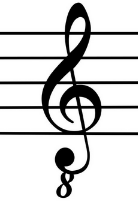
Sometimes I do some arrangements using 11-line system, i.e., a grand staff with the c4 connecting the Bass and treble clef.
Would be useful to have snippets with grand staff option (11-line system).
Maybe, the clef choice could be configurable in the notation options, like here:
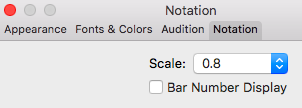
All the best !
Julio
-
Maybe this ?
(harmonic-progression '(0 3 4 4) '(c major))
=> (c4e4g4 f4a4c5 g4b4d5 g4b4d5)Best,
Julio
(harmonic-progression '(1 6 2 5 2) '(c major) :base 1)
or with parsimonious voice-leading:
(closest-path (harmonic-progression '(1 6 2 5 2) '(c major) :base 1))
-
I don't know if I get the point, but in C major the second degree is a minor chord.
Try the gen-chord function
More on chord voicings here:
-
Yes, Janusz. Thank you. I copied all the necessary functions and evaluated all. I´ll try again.
-
I got an error while running (auto-explode4 full)
;;;; Using auto-explode4 function (setf mat1 (make-omn :pitch (rnd-sample 32 (make-scale 'c5 12)) :length (gen-loop 8 (rnd-sample 16 '(s s s -s -s))))) (setf mat2 (make-omn :pitch (rnd-sample 32 (make-scale 'c4 12)) :length (gen-loop 8 (rnd-sample 16 '(s s s -s -s))))) (setf mat3 (make-omn :pitch (rnd-sample 32 (make-scale 'c3 12)) :length (gen-loop 8 (rnd-sample 16 '(s s s -s -s))))) (setf mat4 (make-omn :pitch (rnd-sample 32 (make-scale 'c2 12)) :length (gen-loop 8 (rnd-sample 16 '(s s s -s -s))))) (setf full (merge-voices mat1 mat2 mat3 mat4)) (setf xplode (auto-explode4 full))> Error: Too many arguments in call to #<Compiled-function single-events #x30000133ED8F>:
> 3 arguments provided, at most 2 accepted.
> While executing: single-events, in process Listener-1(7).
> Type cmd-. to abort, cmd-\ for a list of available restarts.
> Type :? for other options.
45 > -
Thanks, Stephane !!
Marvellous Session !
Inspiring !
-
I think that this is the function you mentioned today (november 7 at the zoom session) ?
Great !
-
Nice, Stephane !
But sounds a little different in Sibelius.
Best.
Julio
And Musescore is free !
-
Here is Musescore doing Keyswitches !2 minutes ago, opmo said:Musicxml dose not have this possibility.
But maybe we can just add standard staves to a MusicXML file for doing this.
Put some staves like in the above video and generate it like standard notes for the keyswitches. Simple.
We need opusmodus to create articualtion staves alongside the normal tracks with the same rhythms of the staves (and with articulations instead).
This can be MusicXML staves (we just need normal notes (in a very low register).
I think it´s possible...
All the best !
One interesting thing is to make the articulation notes a little milliseconds before the actual notes (to change the articulation al little before the note).
In my video, I use to copy all the notes of the score, then paste it a little before the notes (like a 32nd or 64th note before) and then edit the articulations.
BEst !
-
-
Dear Stephane,
Musescore is playing it right. You just need to configure the tracks to send it.
I use a loop midi device for sending the information to the tracks of the DAW.
No problem.
The problem is that midi files dont suport some details of the notation.
MusicXML are more comprehensive for the notation diversity.
So, saving as MIDI will lose some details of notation (like tenutos, staccatos, etc, but will gain the track keyswicthes).
So, including the articulation tracks embedded in XML files would be great in this situation.
All the best !
Julio
-
YESSSSSS !!
True, Janusz ! The midi export is great ! It contains a track just for articulations, like this :
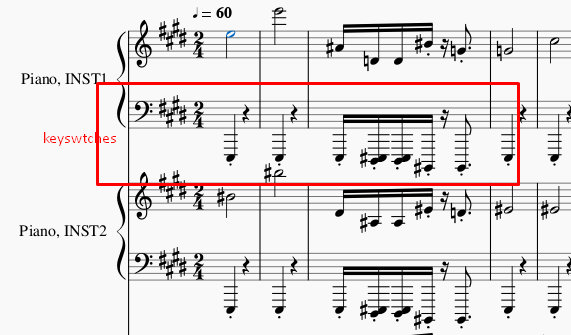
But, as a midi file, it lacks some of the notation information only possible in XML files,
so would be a nice idea to have this very same option in the XML file.
Seems to be easy:
It´s just to compile the articulation staves alongside with the XML output.
A suggestion for implementation.
All the best !
Julio
Actually my file need some debug, since it´s sending double notes in some articulations...
By the way this file was made with my chord library...
Sounds cool
-
This is the exported file from opusmodus.
Maybe the articulations are there, but not in the form of a recognizable track with normal midi notes for keyswithches.
Maybe the articulations are embbeded, but not visible as a track.
Or maybe there´s a different way to import this as a track...
Thank you !
Best,
Julio

No no
Forget....
This is not a keyswich, because the octave is 5
The key switches are very low notes...

-
Dear Friends,
After some time I managed to work with custom articulations, using the def-instruments folder, etc.
This is working great ! No problem (thanks Janusz and Stephane for the support and tips).
The question for me now is that I use to go back and forth to Opus Modus, Musescore (or Finale) and to my DAW (Bandlab) to
work on sections, fine tuning notation, etc.
So, in DAW or musescore, I use a setup like this:
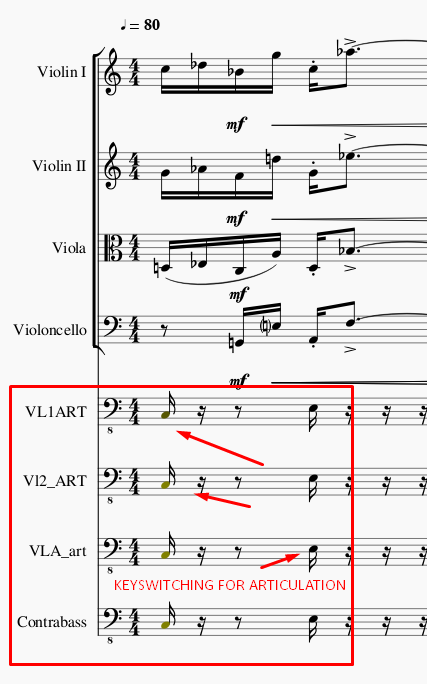
I have four instruments and more four additional staves just for articulation switching.
THE QUESTION :
Is there some way to export from Opusmodus as XML my score with the four instrument staves and more four staves with the exact key switches
opusmodus are sending to the DAW ?
In this way I could just import the XML file to my DAW or Musescore and I could hear it exactly like when previewing in Opusmodus and I also could manage to edit and refine my score at notation program or sequencer.
Thanks a lot !
Best,
Julio




Aschenputtel for Flute Solo
in Made In Opusmodus
Posted
Thank you, Torsten ! All the best !